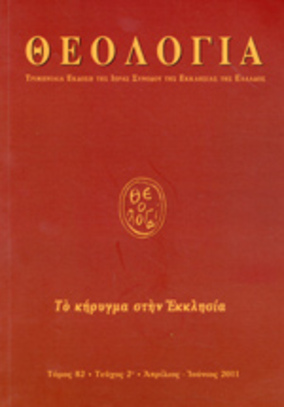Ο Μέγας Φώτιος ως ερμηνευτής της Καινής Διαθήκης
Part of : Θεολογία : τριμηνιαία έκδοση της Ιεράς Συνόδου της Εκκλησίας της Ελλάδος ; Vol.80, No.1, 2009, pages 27-66
Issue:
Pages:
27-66
Parallel Title:
Photios the Great as an interpreter of the new testament
Author:
Abstract:
Patriarch Photios, by the grace of God and the illumination of the HolySpirit, attained to the purification ofhis soul and the enlightenment ofhis spirit.Likewise he became a prominent patriarch of Constantinople and a saint oftheChurch. Moreover, the present study shows that Photios may also be consideredone ofthe great interpreter fathers ofthe Orthodox tradition. Particularly in thefield of New Testament exegesis, his contribution is particularly significant. Hisexegetical work is marked by theologically astute and hermeneutically profoundresponses to essential questions and issues related to the Gospels, the Acts ofthe Apostles, and the Epistles of the Apostle Paul.Included among the hermeneutical works of Photios the Great are theAmphilochia, answers addressed to queries posed by Amphilochios, metropolitanof Kyzikos, and related to the collection, Sacred words, in which issues of thedivine writ are resolved. In this compendium of321 questions, 260 treat Scripturalmatters, while the remaining questions refer to issues of philosophy, grammatology, history, doctrine, medicine, and physics. This remarkable work of Photiosfollows a questions and answers format. In this exegetical genre that exists fromthe 4th century, difficult passages ofHoly Scripture particularly those that presentobscurity, opposition, or contradiction are put forward in the form of questions,and corresponding responses are offered.The Commentaries to the New Testament are also included among thehermeneutical works ofPhotios. This work deals with passages from the gospelsof Matthew, Mark, Luke, and John as well as the epistles of the Apostle Paul.Of course, scholarly opinion is divided on the question of the works authenticity. Based on the evidence we conclude that Photios wrote fragmentaryscholia and not complete commentaries, which are not to be found among hisextant works that have come down to us. Hermeneutical issues related to theNew Testament may also be found in St Photios Epistulae and Homiliai.From the rich hermeneutical oeuvre of the sacred father, it is evident thatPhotios is an expert of the Greek language and a masterful interpreter ofHolyScripture. He follows the historical and grammatical school of criticism, complemented by anagogical or spiritual theory or criticism. For St Photios,Holy Scripture is the main source for the revealed truth of faith, correctdoctrine, and the path oftrue salvation. He recognizes the divine inspiration inthe meaning ofScripture without denying the personal cooperation (synergy) ofthe holy authors during the documentation of the divine word, based on theerudition and personal charismata of each. In this way the variant accounts ofthe events ofthe life ofChrist as well as the apparent or real inconsistencies thatmay be observed, mainly in the texts of the gospels, are explained. St Photiosalso defends the unity of the two Testaments, as for him they are equallyauthoritative and valid. They are of the same value and merit because the OldTestament contains the promises of God to the people ofIsrael, whereas in theNew Testament they are realized in the person of the incarnate Jesus Christ.For this reason he understands biblical interpretation as an ecclesial act.From the representative sample of Photios interpretations on difficult passages of the New Testament, one ascertains that the unclear and obscure passages of the Old Testament are definitively and authentically clarified via theincarnation of the Son and Logos of God. The obscurity or misapprehension ofthe words of Jesus relates even to his disciples prior to the decent of the HolySpirit. Nevertheless, according to St Photios, after a more systematic approach,it becomes evident that the points that seem to exhibit inconsistency or contradiction in reality are not incongruous. With the systematic study ofthe sacredtext within its broader framework, as well as biblical theology and the orthodoxinterpretive tradition in general, these antitheses are settled and the true spiritofthe sacred authors and of the revealed Logos of God are understood.
Subject:
Subject (LC):
Keywords:
Καινή Διαθήκη, ερμηνεία
Notes:
Εισήγηση πού εγινε στο Διορθόδοξο κέντρο τής Εκκλησίας τής Ελλάδος κατά τήν εορτή τού ιερού Φωτίου, 6 Φεβρουάριου 2009, ένώπιον τού Μακαριωτάτου Αρχιεπισκόπου Αθηνών καί πάσης Ελλάδος κ.κ. Ιερωνύμου, μελών τής Ίεράς Συνόδου, τών Κοσμητόρων, Προέδρων καί Καθηγητών τών Θεολογικών Σχολών Αθηνών καί Θεσσαλονίκης.




